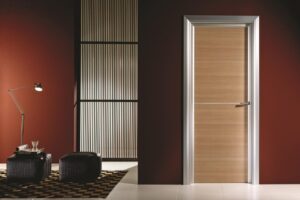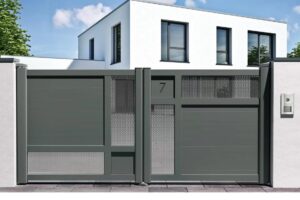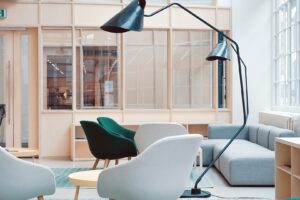
The modern office is undergoing a significant transformation. Gone are the days of sterile, one-size-fits-all workspaces. Today, office interior design prioritizes flexibility, functionality, and fostering a sense of community. This shift reflects the evolving nature of work itself, with a growing emphasis on employee well-being and collaborative working styles. Businesses that embrace these trends are creating work environments that not only attract and retain top talent but also drive productivity, innovation, and success. This blog delves into the hottest office interior design concepts for 2024, offering valuable insights to help you transform your workspace into a hub of creativity, collaboration, and employee satisfaction.

Best Office Interior Design
Embracing the Power of Nature: Biophilic Design
The calming influence of nature extends far beyond a simple potted plant. Biophilic design integrates natural elements into the office environment, fostering a sense of connection with the outdoors. This translates into features that not only enhance aesthetics but also contribute to employee well-being.
Abundant Greenery: Live plants are more than just decorative elements. They act as natural air purifiers, reducing toxins and pollutants, and improving air quality. Strategically placed greenery, from low-maintenance succulents to statement-making hanging ferns, injects life and vibrancy into the space.
Natural Lighting: Maximizing natural light is a key aspect of biophilic design. Large windows and skylights bathe the workspace in natural illumination, reducing reliance on artificial lighting and boosting employee mood. Natural light exposure helps regulate circadian rhythms, promoting better sleep and overall well-being.
Natural Materials: Wood, stone, and other organic materials create a warm and inviting atmosphere. Opt for furniture crafted from sustainable sources like bamboo or recycled wood to add an eco-conscious touch and further connect with the natural world.
Enhancing Flexibility with Activity-Based Working
Activity-based working (ABW) moves away from the one-size-fits-all approach to office design. It caters to a diverse range of work styles and activities by providing employees with a variety of designated spaces to suit their needs. This empowers them to choose the environment that best facilitates their tasks, fostering increased productivity and creativity. Here are some key areas found in an ABW layout:
Focus Pods: Small, enclosed spaces ideal for concentrated work that requires minimal distraction. These pods offer a haven for employees to tackle tasks requiring deep focus, like writing reports or preparing presentations.
Collaboration Zones: Open areas with comfortable seating, whiteboards, and even mobile furniture for flexible layouts. These zones facilitate brainstorming sessions, team meetings, and collaborative projects, encouraging interaction and the exchange of ideas.
Quiet Rooms: Private spaces for taking phone calls, video conferencing, or simply escaping the hustle and bustle for some focused work. Whether it’s a quick call with a client or a moment of meditation, quiet rooms provide a refuge for employees who need a temporary escape from the main workspace.
Social Lounges: Casual areas with comfortable seating, coffee machines, and game tables to encourage interaction and relaxation. These lounges foster a sense of community and provide employees with a space to unwind, socialize with colleagues, or simply take a break from their desks.
By implementing ABW, office interior design in Singapore and around the world empowers employees to take ownership of their workspace and work style, ultimately leading to a more productive and engaged workforce.
Prioritizing Employee Well-being: Design for Health and Happiness
Employee well-being has become a top priority for modern businesses. Office design plays a crucial role in promoting physical and mental health. Consider incorporating elements that go beyond aesthetics and actively contribute to employee well-being:
Ergonomic Furniture: Investing in adjustable chairs and desks is an investment in employee health. Proper posture reduces the risk of musculoskeletal disorders, such as back pain and carpal tunnel syndrome, leading to a more comfortable and productive work experience.
Natural Ventilation: Proper air circulation is essential for maintaining good air quality and employee comfort. Utilize operable windows, strategically placed ceiling fans, or even an air purification system to ensure fresh, clean air throughout the workspace.
Adjustable Lighting: Offer a variety of lighting options to cater to individual preferences and tasks. Bright task lighting allows for focused work, while warm, ambient lighting creates a more relaxed and social atmosphere. Consider implementing dimmers or installing lighting systems that adjust automatically based on natural light levels.
Wellness Amenities: Creating dedicated spaces for relaxation and rejuvenation demonstrates a commitment to employee well-being. Consider incorporating yoga studios, meditation rooms, or even on-site gyms to encourage employees to prioritize their physical and mental health during the workday.
Investing in employee well-being through thoughtful office interior design fosters a positive work environment, leading to increased employee satisfaction, engagement, and retention.
Technology Integration for Seamless Workflows
Technology is an integral part of the modern office. A well-designed space seamlessly integrates technology to enhance communication, collaboration, and efficiency. Here are some key considerations for incorporating technology into your office design:
Hidden Technology: Clutter can be a major distraction. Discreetly integrate charging stations, power outlets, and projection screens into furniture or walls. This maintains a clean and uncluttered aesthetic while ensuring technology remains readily accessible to employees.
Interactive Displays: Large touchscreens or interactive whiteboards become hubs for brainstorming sessions and presentations. These interactive displays allow for real-time collaboration, fostering a more engaging and dynamic work environment.
Smart Building Systems: Implement smart technology for automated climate control, lighting adjustments, and space reservation. This creates a more comfortable and efficient work environment while reducing energy consumption. Imagine a system that automatically adjusts the temperature based on occupancy or allows employees to reserve conference rooms through a user-friendly app.
Sustainable Design Practices: Design with the Environment in Mind
Environmental consciousness is at the forefront of modern design. Sustainable office interior design practices not only benefit the environment but also contribute to a healthier work environment:
Recycled and Upcycled Materials: Opt for furniture crafted from recycled or upcycled materials to minimize environmental impact. This approach not only promotes sustainability but can also add a unique character to the workspace.
Energy-Efficient Lighting: Utilize LED lighting fixtures to reduce energy consumption and create a brighter, more sustainable workspace. LED lights are not only energy-efficient but also last significantly longer than traditional incandescent bulbs, further reducing environmental impact and maintenance costs.
Water-Saving Fixtures: Install low-flow faucets and toilets to conserve water. Every drop counts, and implementing these water-saving measures demonstrates a commitment to environmental responsibility.
Proximity to Public Transportation: Locate your office in a location with easy access to public transportation options, encouraging employees to utilize eco-friendly commuting methods. This not only reduces reliance on personal vehicles but also contributes to a healthier environment for everyone.
By incorporating sustainable design practices, businesses can create a more environmentally friendly workspace while promoting a culture of social responsibility. This resonates with a growing number of employees who are increasingly conscious of their environmental impact.
Final Words
Office Interior Design Singapore 2024 goes beyond aesthetics. It’s about creating a functional, flexible, and employee-centric space that fosters productivity, well-being, and a sense of community. By embracing these trends, businesses can design workspaces that attract and retain top talent, enhance collaboration, and drive success. A well-designed office becomes more than just a place to work; it becomes an inspiring environment that fuels creativity, innovation, and a sense of belonging.
So, are you ready to reimagine your workspace? Take these trends into consideration and embark on a journey to transform your office into a space that inspires and empowers your employees.



